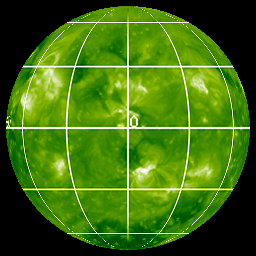On Feb. 6, NASA’s twin STEREO probes moved into position on opposite sides of the sun, and they now are beaming back uninterrupted images of the entire star — front and back.
”For the first time ever, we can watch solar activity in its full three-dimensional glory,” says Angelos Vourlidas, a member of the STEREO science team at the Naval Research Lab in Washington, D.C.
”This is a big moment in solar physics,” says Vourlidas. “STEREO has revealed the sun as it really is — a sphere of hot plasma and intricately woven magnetic fields.”
Read more about this story by logging into NEON, join the NASA Explorer Schools group, and find the “GENESIS: What Are We Made of? The Sun, Earth and You” forum. The complete write-up on this exciting new development is available in that forum.
 This movie shows a spherical map of the Sun, formed from a combination of STEREO Ahead and Behind beacon images, along with an SDO/AIA image in between. The movie starts with the view of the Sun as seen from Earth, with the 0 degree meridian line in the middle. The map then rotates through 360 degrees to show the part of the Sun not visible from Earth. The black wedge shows the part of the Sun not yet visible to the STEREO spacecraft.
This movie shows a spherical map of the Sun, formed from a combination of STEREO Ahead and Behind beacon images, along with an SDO/AIA image in between. The movie starts with the view of the Sun as seen from Earth, with the 0 degree meridian line in the middle. The map then rotates through 360 degrees to show the part of the Sun not visible from Earth. The black wedge shows the part of the Sun not yet visible to the STEREO spacecraft.For more information about the STEREO spacecraft, visit the mission website.

 On Feb. 14, 2011, NASA’s Stardust-NExT (New Exploration of Tempel 1) mission will encounter Comet Tempel 1, providing a unique opportunity to measure the dust properties of two separate comets (Wild 2 and Tempel 1) with the same instrument for accurate data comparison. The encounter also will provide a comparison between two observations of a single comet, Tempel 1, taken before and after a single orbital pass around the sun.
On Feb. 14, 2011, NASA’s Stardust-NExT (New Exploration of Tempel 1) mission will encounter Comet Tempel 1, providing a unique opportunity to measure the dust properties of two separate comets (Wild 2 and Tempel 1) with the same instrument for accurate data comparison. The encounter also will provide a comparison between two observations of a single comet, Tempel 1, taken before and after a single orbital pass around the sun. NASA’s Deep Impact mission observed Comet Tempel 1 in the summer of 2005, as the comet was inbound toward the sun on its approximately 5.5-year orbit between Mars and Jupiter. Deep Impact’s primary mission was to deliver a special impactor spacecraft into the path of Comet Tempel 1. The spacecraft — and many ground-based observers — observed the impact and the ejected material. Scientists were surprised the cloud was composed of a fine, powdery material, not the expected water, ice and dirt. The spacecraft did find the first evidence of surface ice on a comet instead of just inside a comet.
NASA’s Deep Impact mission observed Comet Tempel 1 in the summer of 2005, as the comet was inbound toward the sun on its approximately 5.5-year orbit between Mars and Jupiter. Deep Impact’s primary mission was to deliver a special impactor spacecraft into the path of Comet Tempel 1. The spacecraft — and many ground-based observers — observed the impact and the ejected material. Scientists were surprised the cloud was composed of a fine, powdery material, not the expected water, ice and dirt. The spacecraft did find the first evidence of surface ice on a comet instead of just inside a comet.